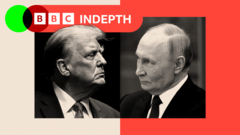In recent developments, the relationship between Donald Trump and Vladimir Putin has severely deteriorated, marking a stark shift in US-Russian diplomacy. A popular Russian newspaper recently metaphorically depicted the two leaders as locomotives on a collision course, a reflection of the escalating tensions surrounding Russia's military operations in Ukraine.
The so-called 'Putin locomotive' continues to charge ahead with its military agenda, showing little interest in a ceasefire despite international pressure. Conversely, the 'Trump locomotive' is picking up speed as Trump intensifies sanctions and threats towards Russia and its trading allies, including India and China. This dynamic raises questions about whether a definitive clash between the US and Russia over Ukraine is imminent or if diplomatic channels are still open.
Initially, relations appeared to be improving following Trump’s return to the presidency, illustrated by mutual interests and an unexpected US backing of Russia at the United Nations. Talks of a summit between the two leaders seemed plausible, with positive gestures exchanged, including President Putin presenting Trump with a portrait during private meetings.
However, as Russia continues its military operations, frustration mounts in Trump's camp. His recent alarm over continued bombings of Ukrainian cities has led him to issue a series of ultimatums to Putin, revising deadlines rapidly, which some observers argue may reduce their efficacy.
Despite the strained atmosphere, the possibility of a diplomatic solution is still alive. Trump's envoy, Steve Witkoff, is set to visit Moscow for discussions, and speculation arises about potential concessions that could facilitate peace negotiations. Analysts suggest that meaningful dialogue could emerge, dependent on whether Trump's negotiation tactics shift from pressures to more constructive proposals.
As the situation develops, both leaders seem to stand firm on their positions: Trump seeks a comprehensive ceasefire while Putin continues to push for strategic territorial gains. The interplay of power and diplomacy in this confrontation remains uncertain, yet open to resolution with the right approach.
The so-called 'Putin locomotive' continues to charge ahead with its military agenda, showing little interest in a ceasefire despite international pressure. Conversely, the 'Trump locomotive' is picking up speed as Trump intensifies sanctions and threats towards Russia and its trading allies, including India and China. This dynamic raises questions about whether a definitive clash between the US and Russia over Ukraine is imminent or if diplomatic channels are still open.
Initially, relations appeared to be improving following Trump’s return to the presidency, illustrated by mutual interests and an unexpected US backing of Russia at the United Nations. Talks of a summit between the two leaders seemed plausible, with positive gestures exchanged, including President Putin presenting Trump with a portrait during private meetings.
However, as Russia continues its military operations, frustration mounts in Trump's camp. His recent alarm over continued bombings of Ukrainian cities has led him to issue a series of ultimatums to Putin, revising deadlines rapidly, which some observers argue may reduce their efficacy.
Despite the strained atmosphere, the possibility of a diplomatic solution is still alive. Trump's envoy, Steve Witkoff, is set to visit Moscow for discussions, and speculation arises about potential concessions that could facilitate peace negotiations. Analysts suggest that meaningful dialogue could emerge, dependent on whether Trump's negotiation tactics shift from pressures to more constructive proposals.
As the situation develops, both leaders seem to stand firm on their positions: Trump seeks a comprehensive ceasefire while Putin continues to push for strategic territorial gains. The interplay of power and diplomacy in this confrontation remains uncertain, yet open to resolution with the right approach.

















